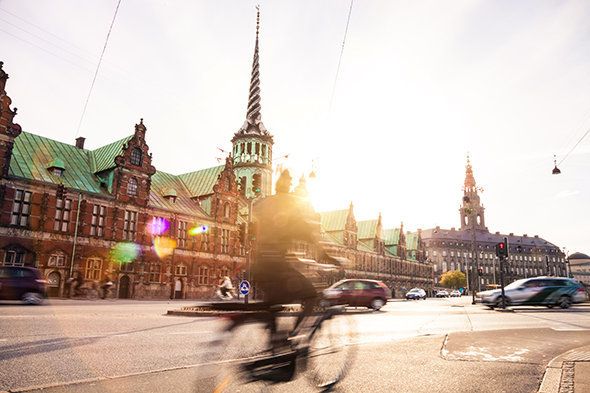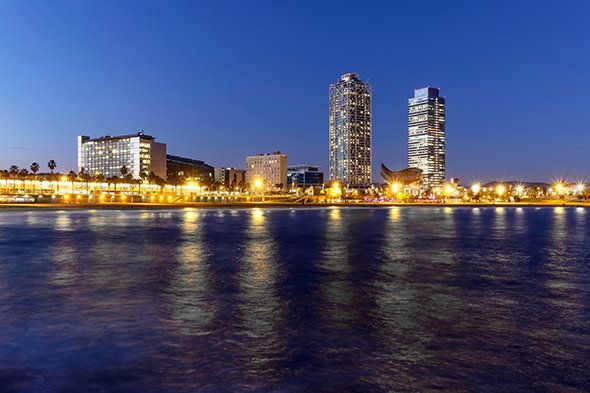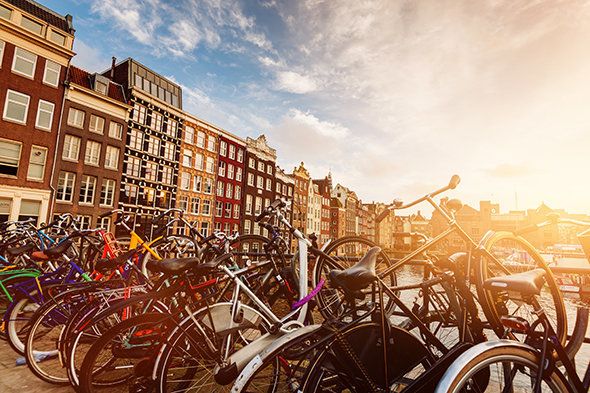What is a smart city? It’s where urban networks – human and technological – are integrated in order to optimise convenience, efficiency and the quality of life for the people who live and work in it.
Such cities aim to be self-sustainable, with minimal impact on the environment, where new innovations enable an intelligent exchange of energy and resources, and where connectivity via ICT (Information and Communication Technology) and the IoT (Internet of Things) puts citizens in control, able to improve their day-to-day lives through their own decision-making.
Here are some of the most ambitious and successful of Europe’s smart cities, and the ways in which they are changing how we think about the urban environment.
Advertisement
COPENHAGEN

Getty
Frequently cited as the smartest of smart cities, Copenhagen has the lowest carbon footprint per capita in the world. Copenhagen Connecting combines wireless data from phones, GPS systems in buses, and sensors in sewers and public dustbins with the aim of making the city’s carbon footprint even smaller through efficient waste management and shorter journey times. Similarly, the Copenhagen Solutions Lab is an incubator for initiatives that aim to reduce air-pollution - take smart parking, for example, where drivers can use an app to find parking spaces rather than simply drive around in circles, increasing exhaust fumes and creating unnecessary congestion.
VIENNA

Getty
Through the public-private entity, TINA Vienna, the Austrian capital has been developing smart city strategies for several years now. One of the most successful has been the Citizen Solar Power Plant. Residents buy either a half or whole solar panel, which is then rented by Wein Energie, the city’s energy company, who eventually buy the panels back. New technology is also seeing the development of bio-solar roofs on individual buildings, which combine solar with the capacity to grow grass and plant life. Green roof systems provide habitat to pollinators (good news for endangered bees), more effective irrigation, better preservation of the roof structure, and ultimately lower energy and maintenance costs for the building itself.
BARCELONA

Getty
Barcelona is a city renowned for its visionary approach to architecture and design and through the 22@ District of Innovation, launched in 2,000, it has sought to combine these qualities with digital technologies in order to explore the possibilities of the smart city. The district consists of five ‘knowledge clusters’ – ICT, Bio-Medical, Design, Energy and Media – and seeks new ways to combine them to provide a more sustainable urban model. Taking advantage of 500kms of fibre optic cable within the city, the 22@ District uses all kinds of sensors to monitor noise and air pollution, congestion and how people orient themselves around its structures. It then analyses this data to create an environment that is an enjoyable and dynamic place to live and work, as well as one that has a beneficial impact on the environment.
Advertisement
LONDON

Getty
Buildings are responsible for 40 percent of the world’s energy consumption, so smart cities of the future need to completely rethink how they are made. Some fascinating new innovations we might see down the line include bricks ‘grown’ from natural cement by bacteria, floor tiles that can turn footsteps into electrical power, and power-generating elevators. As one of the world’s top cities for green construction, London will certainly be a part of that, but for now it expresses its smart city credentials in other ways, like in the Energy ‘Hub’ School under construction in Crouch Hill which absorbs more carbon dioxide than it uses and feeds surplus energy to nearby homes. Or the Waitrose in Stratford City, where all food waste is converted into energy and put back into the national grid. Then there’s BowZed in Bow, a block of flats that are so well insulated they don’t need central heating, and enjoy electricity from solar and wind power integrated into the buildings.
AMSTERDAM

Getty
Like Copenhagen, Amsterdam is a dedicated cycling city, which already means it is relatively green. What makes it smart is its use of open-source data as part of the Amsterdam Smart City initiative, founded in 2009 and involving more than 70 projects throughout the city. Living Labs, for example, are communities that act as testbeds for ideas before potentially rolling them out across the city. In IJburg they have created SmartWork@IJburg that provides free wi-fi and local co-working spaces so people can work remotely in their area, without having to commute. The Amsterdam Energy Atlas is another project, mapping the energy potential of the city. Then there’s TrafficLink, which combines data on traffic from private and public sources to offer up-to-the-minute information on what the state of the roads are like, suggesting the quickest – and least polluting – routes from A to B.